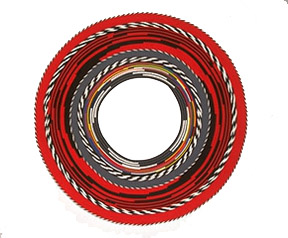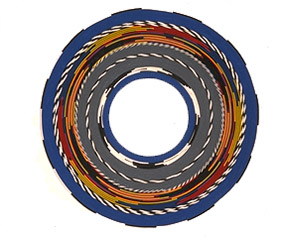

DNA - painted welt 73.5" diameter June 1998 SOLD
In 1994, I took the painted rope objects off the wall and began fabricating large scale painted steel structures. However, in 1998, I again found my interest return to the wall. The works still retain a circular or ring format, but other concerns are beginning to emerge. I began to recognize that rules of the physical, intellectual, and secular world were simultaneously parts of my fabrication process. Today's artist/designer, the product of an industrial education, often uses an imaginary internalized industrial grid to map out pictorial space and explore the dynamic vectors of vision within the abstract context. The rectangle is often associated with the concept of representing a window to the world; providing a frame for the mirroring of vision in the world, resulting with the rationalization of designing around the laws of color theory and psychological optics.
The circle or ring icon is not generally associated with western European design sensibilities and the associated traditional challenge of developing a strategy addressing the dynamics of the rectangle. The circular format provides the artist a totally unique set of limitations and challenges. The primary challenge is to provide an alternative to the tendency or immediate urge to be visually drawn to the center and away from the outer circumference/edge. The hole and not the whole becomes the issue. I began to recognize that the focal point issue is virtually eliminated by thinking of the format as a ring…the vortex quality is transformed into a sense of revolution. The icon or the whole establishes a state of revolvement, and the images/concepts associated with the wheel of fortune, and the associated carnival barker's cry …"around and around it goes and where it stops nobody knows." My interest expanded from issues or investigations of cultural spiritualism…man's search for purpose, and expanded to include issues relative to man's search for ways to foretell his destiny or the future.
In 2000, I began addressing the interior space of the ring. For years I have been fascinated by images of the Japanese Zen gardens, but felt uncomfortable just adapting or using them without feeling a clear sense or appreciation of their essence. I began visiting gardens…walking their paths…and discovered the unique qualities they hold. Labyrinths, often placed in the floors of churches, provided the parishioners with a means to fulfill a pilgrimage. I began to see the Zen garden icon possessing similar qualities as the labyrinth and would suggest that the labyrinth floor sculptures are analogous to my Japanese Zen wall icons.
May 29, 2003

Pushing the outer edge painted welt 83. 5" diameter June 1998 SOLD

Zones & Codes - painted
welt 92" diameter October 1999